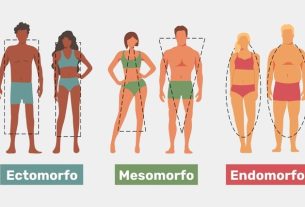Eating disorders are a range of conditions expressed through abnormal or distorted eating habits. Read more!
Some people may see eating disorders as just a phase, a lifestyle or even a “fad”. Far from that, they are serious mental disorders.
They affect people physically, psychologically and socially and can have life-threatening consequences.
In fact, eating disorders are now officially recognized as mental disorders by the Diagnostic and Statistical Manual of Mental Disorders (DSM).
In the US alone, it is estimated that 20 million women and 10 million men have or have had an eating disorder at some point in their lives.

What are eating disorders?
Eating disorders are a range of conditions expressed through abnormal or distorted eating habits.
They usually result in an obsession with food, body weight or body shape, and often result in serious health consequences.
In some cases, eating disorders result in death.
Individuals with eating disorders can experience a wide variety of symptoms.
However, most include severe food restriction, binge eating, or excessive behaviors, such as constantly vomiting or exercising excessively.

Although eating disorders can affect people of any gender and at any stage of life, they are most often reported in adolescents and young women.
In fact, up to 13% of young people may have at least one type of eating disorder before the age of 20.
What causes them?
Experts believe that eating disorders can be caused by a variety of factors.
One of them is genetics. Studies with twins separated at birth and adopted by different families have shown some evidence that eating disorders can be hereditary.
This research has shown that, in general, if one twin develops an eating disorder, the second has a 50% chance of developing it too, on average.
Personality traits are another cause. In particular, neuroticism, perfectionism and impulsivity are three personality traits often linked to a greater risk of developing an eating disorder.
Other potential causes are everyday pressures, usually harmless, such as cultural preferences for thinness in society and exposure to media promoting such ideals.

In fact, certain eating disorders appear to be almost non-existent in cultures that have not been exposed to Western ideals of thinness.
That said, culturally accepted ideals of thinness are very present in many areas of the world.
However, in some countries, few individuals end up developing an eating disorder. Thus, it is likely that a number of factors are to blame.
The 6 most common types of eating disorders and their symptoms
1. Anorexia Nervosa

Anorexia nervosa is probably the best-known eating disorder.
It usually develops during adolescence or young adulthood and tends to affect more women than men.
People with anorexia often consider themselves overweight, even if they are underweight.
They tend to constantly monitor their weight, avoid eating certain types of foods, and severely restrict their calories.
These individuals may also have difficulty eating in public and have a strong desire to control the environment around them, limiting their ability to be spontaneous.
Individuals with the restricted type lose weight only through dieting, fasting, or excessive exercise.
Individuals with binge eating may consume large amounts of food or eat very little.
In both cases, after eating, they purge the food using activities that include vomiting, using laxatives or diuretics, or excessive exercise.
Anorexia can be very harmful to the body. Over time, individuals who live with it may experience thinning of their bones, infertility, and brittle hair and nails.
In severe cases, anorexia can result in heart, brain, or multiple organ failure and death.
2. Bulimia Nervosa

Bulimia nervosa is another well-known eating disorder.
Like anorexia, bulimia tends to develop during adolescence and early adulthood and appears to be less common among men than women.
People with bulimia often eat unusually large amounts of food in a relatively short period of time.
Each episode of binge eating usually continues until the person is painfully full.
Furthermore, during a party or celebration, a person often feels like they cannot stop eating or control how much they are eating.
The disorder can happen with any type of food, but it most commonly occurs with foods that the individual would normally avoid.
Symptoms can appear very similar to binge-eating or purging subtypes of anorexia nervosa.
However, individuals with bulimia generally maintain a relatively normal weight rather than becoming underweight.
In severe cases, bulimia can also create an imbalance in the body’s levels of electrolytes, such as sodium, potassium, and calcium. This can cause a stroke or heart attack.
3. Binge eating disorder

Binge eating was officially recognized as an eating disorder relatively recently.
However, it is currently believed to be one of the most common eating disorders, especially in Western countries.
Binge eating disorder typically begins during adolescence and early adulthood, although it can also develop later.
Individuals with this disorder have symptoms similar to those with bulimia or the binge-eating subtype of anorexia.
For example, they typically eat unusually large amounts of food in relatively short periods of time and often feel a lack of control when drinking alcoholic beverages.
However, unlike the previous two disorders, people with binge eating disorder do not restrict calories or use purging behaviors such as vomiting or excessive exercise to compensate for their binges.
The most common symptoms of binge eating disorder include: eating large amounts of food quickly, in secret, and until you become uncomfortably full, despite not feeling hungry; feelings of anguish, such as shame, disgust or guilt, when thinking about binge eating behavior, etc.
4. Alotriofagia

Allotriophagia is another entirely new condition, only recently recognized as an eating disorder by the DSM.
Individuals with allotriophagia have an appetite for non-food things or substances, such as earth, chalk, soap, paper, hair, fabric, wool, washing powder, coins, etc.
Allotriophagia can occur in adults, as well as in children and adolescents. That being said, this disorder is most often seen in children, pregnant women, and people with mental disabilities.
Individuals with allotriophagia are at greater risk of poisoning, infections, intestinal injuries and nutritional deficiencies. Depending on the substances ingested, allotriophagia can be fatal.
However, to be considered allotriophagy, the ingestion of non-food substances must not be a normal part of someone’s culture or religion.
Furthermore, it should not be considered a socially acceptable practice by a person’s peers.
5. Rumination Disorder

Rumination disorder is another recently recognized eating disorder.
Describes a condition in which a person regurgitates food that they have already chewed and swallowed, chews it again, and then swallows it again or spits it out.
This rumination typically occurs within the first 30 minutes after a meal. Unlike medical conditions such as reflux, it is voluntary.
This disorder can develop during childhood, adolescence or adulthood.
In children, it tends to develop between three and 12 months and often disappears on its own. Children and adults with the condition often require therapy to resolve it.
If left unresolved in infants, rumination disorder can result in weight loss and severe malnutrition that can be fatal.
Adults with this disorder may restrict the amount of food they consume, especially in public. This can cause them to lose weight.
6. Avoidant Restrictive Eating Disorder

Avoidant-restrictive eating disorder is a new name for an old disorder.
In fact, it replaces what was known as “infancy eating disorder,” a diagnosis previously reserved for children under seven years of age.
Although it usually develops during childhood, it can persist into adulthood. Furthermore, it is equally common in men and women.
Individuals with this disorder experience disturbed eating due to a lack of interest in eating or a distaste for certain smells, flavors, colors, textures, or temperatures.
The most common symptoms of eating disorders
Avoiding or restricting food intake that prevents the person from ingesting enough calories or nutrients; eating habits that interfere with normal social functions, such as eating with others; weight loss or poor development for age and height; nutritional deficiencies or dependence on supplements or tube feeding.
Furthermore, it does not include the avoidance or restriction of foods due to lack of availability or religious or cultural practices.
The categories above are intended to provide a better understanding of the most common eating disorders and dispel the myths that many people have about them.
Eating disorders are mental disorders with seriously harmful physical and emotional consequences.

They are not fads, phases, or something someone consciously chooses to participate in.
If you have an eating disorder or know someone who may have one, seek help from a healthcare professional who specializes in eating disorders.
Also read about the 7 bizarre diets that exist around the world.
Share the post with your friends!
Fonte: HealthLine





